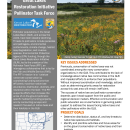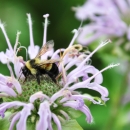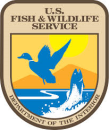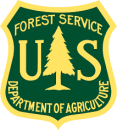Location











States
MichiganEcosystem
Prairie, WetlandIntroduction
Pollinator populations in the Great Lakes Basin (GLB), and across the world, have been steadily declining (IPBES, 2016). Threats to pollinators include parasites and pathogens, environmental contaminants, climate change climate change
Climate change includes both global warming driven by human-induced emissions of greenhouse gases and the resulting large-scale shifts in weather patterns. Though there have been previous periods of climatic change, since the mid-20th century humans have had an unprecedented impact on Earth's climate system and caused change on a global scale.
Learn more about climate change , habitat loss/degradation, and invasive species invasive species
An invasive species is any plant or animal that has spread or been introduced into a new area where they are, or could, cause harm to the environment, economy, or human, animal, or plant health. Their unwelcome presence can destroy ecosystems and cost millions of dollars.
Learn more about invasive species . In the GLB, the populations of several pollinators have declined dramatically, including those of the Poweshiek skipperling (Oarisma poweshiek) (Swengel et al., 2011), Mitchell’s satyr butterfly (Neonympha mitchellii mitchellii) (Cayton and Haddad, 2018), and Rusty-patched bumble bee (Bombus affinis), which are federally listed as Endangered.
Pollinator conservation has gained national attention over the last decade, culminating in a presidential memo encouraging the protection of pollinators across four thematic areas:
- Increasing and improving pollinator habitat
- Developing public-private partnerships to enhance effectiveness and reach of pollinator activities
- Conduct research to understand, prevent, and recover pollinator losses
- Expand public education programs and outreach
In order to benefit the pollinators of the GLB, the Environmental Protection Agency (EPA) funded the Great Lakes Restoration Initiative’s (GLRI) Pollinator Task Force (PTF). The PTF is a collaboration between the Fish and Wildlife Service (FWS), U.S. Forest Service (USFS), National Park Service, Natural Resources Conservation Service (NRCS), United States Geological Survey (USGS), and others. The PTF’s mission is to “catalyze native bee conservation by coordinating and funding actions that efficiently maximize native bee abundance, distribution, diversity and resilience within the Great Lakes Basin.”
The PTF chose to initially focus on native bees, since native bees are a critically imperiled group of pollinators in North America (Burkle et al., 2013), are keystone species, are considered the most effective native pollinators in the GLB, and share complimentary habitat with many other pollinators. The PTF supports efforts that increase the acres of on-the-ground pollinator-specific habitat by funding projects, and by conducting surveys and research focused on native bees in the GLB.
Key Issues Addressed
There is a general lack of knowledge about which species of native bees are still present, where they are located, the overall health of their populations and habitats, and what habitat conditions are needed to support thriving and diverse pollinator populations. Without this knowledge, and given the limited resources available, actions to enhance populations of native bees and their habitat across the vast extent of the GLB will remain inefficient.
Previously, conservation of native bees was not coordinated among the many conservation organizations in the GLB that are working towards “maximizing native bee abundance, distribution, diversity, and resilience within the GLB”. Greater coordination among these organizations can lead to more effective and efficient actions across the GLB without “reinventing the wheel”.
Collaborative actions are pivotal to enhance native bee populations across the GLB and educating the public and regional decision makers is crucial in mobilizing support for these actions.
Project Goals
- Determine distribution and status of native bee species and their habitats within the GLB
- Identify and prioritize activities and focus areas in the GLB for on-the-ground conservation efforts of native bees and their habitats
- Understand the key threats and stressors to native bees in priority focus areas including critical information on the effects of parasites and pathogens, contaminants, climate change, habitat loss/degradation, and invasive species
- Implement, with partners and collaborators, habitat enhancement, restoration and protection in focus areas; implement vegetative management actions that conserve or enhance existing habitats for native bee species
- Monitor, evaluate and/or adaptively manage Task Force strategy and projects
- Educate the public and regional decision makers about the importance of native bees and other pollinators and mobilize them to support pollinator conservation
Project Highlights
Rare Bee Discovery: During a GLRI Pollinator Task Force coordinated and funded survey, the Forest Service found a rare cuckoo bee (Epeoloides pilosulus), which had not been seen in Wisconsin since 1910!
- Finding Common Ground: The Structured Decision Making Workshop (SDMW) yielded program effectiveness criteria and measurable objectives for funding and evaluating projects using ranking and scaling exercises, and alternative scenarios.
- Adaptable Planning: Collaboration with partners produced a five-year plan that serves as an adaptable “living document”, reflecting the priorities and direction of this broad partnership. The plan helps facilitate inclusive, coordinated, and cost-effective efforts to conserve native insect pollinators throughout the GLB.
- Consolidating Data and Pinpointing Gaps: By consolidating information from a variety of sources, including Bumblebee Watch, NatureServe, the IUCN, Wisconsin’s Department of Natural resources, the Bumble Bee Brigade, and others, the PTF was able to pinpoint gaps in knowledge about native bees and focus their attention for surveys and studies. Some priority areas that have been surveyed include the Detroit River International Wildlife Refuge, Shiawassee National Wildlife Refuge, and the Schlee, Malan and Edger Waterfowl Production Areas.
- Standardized Surveys: The PTF was instrumental in developing a standardized survey methodology that could be used across the GLB region by various agencies and organizations. The survey uses bowl traps and netting. Data gathered can be pooled with data collected from surveys using different methodologies.
- Priority Focus Areas: Coordination among PTF agencies resulted in the establishment of priority focus areas for native bee habitat restoration across the GLB based on best available data and will be updated as better data becomes available. Criteria for priority area selection included that they be on Federal lands, be part of a Protected Area (PADUS data), and data from connectivity and native bee habitat suitability models.
- Acres Restored: GLRI PTF partners completed 100 acres of pollinator habitat restoration with Partners for Fish and Wildlife programs, private landowners, and other partners.
Lessons Learned
Using a PrOACT (Problem, Objectives, Action and Alternatives, Consequences and Trade-offs) approach during the Structured Decision Making Workshops allowed for an effective, equitable, and transparent process for enacting the PTF’s strategy. This process promoted participant buy-in and ensured that the concerns and needs of all participants were being met. This collaborative strategy allowed for some key insights about the importance of effectively communicating the story of the GLRI’s PTF successes to the EPA. Effective communication is important to receive continued funding, and to determine how to allocate those resources among partners for greatest impact.
Effective outreach to potential partners is crucial to the success of collaborative projects like the GLRI’s PTF. Being successful often requires persistence in reaching out to key partners and use of a diversity of communication channels such as emails, phone calls, and participation in in-person or virtual events.
The PTF has followed a strategy of reaching out in phases to existing partnership networks. Since the core PTF partners are from federal agencies, the initial outreach phases started by reaching out to other partners in federal agencies. These federal partners in turn have established partnerships at the state level, and state partners have connections with private landowners and individuals. This strategy of leveraging existing partnership networks has allowed the PTF to reach out quickly to a number of partners at multiple scales.
Reaching out to tribal partners has been a challenge for the GLRI’s PTF. This challenge is not unique to this partnership and is one that the PTF is seeking to overcome. The PTF has recently been working with FWS tribal liaisons and talks with tribal partners are underway. The PTF is hopeful that this will help create long-lasting relationships with tribal partners who share a vision of having resilient and diverse pollinator communities in the GLB.
The PTF learned that dedicating resources to develop a communication strategy early in the process of partnerships, and regularly revising the communication strategy throughout the duration of the partnership, can help overcome communication challenges. The PTF’s quarterly updates have been a helpful way to increase internal communication within agencies and among agencies. Recent efforts to promote PTF activities on agency websites have been successful in increasing communication among federal and state agencies and to external partners. Despite these efforts, more external and internal communication and promotion is needed.
Next Steps
- Expand communication strategy to reach more partners and stakeholders
- Expand the native bee surveys to FWS Legacy Region 5 and continue refining the survey objectives and protocols
- Contribute to efforts of the National Bee Monitoring group
- Host workshops to continue discussing PTF projects, share project updates, and discuss emerging research and strategies such as use of eDNA
- Implement more than 1800 acres of planned habitat restoration over the next three years
- Expand Bombus surveys throughout the basin in partnership with Michigan State University and Michigan Natural Features Inventory in focus areas on FWS, NPS, and USFS lands
Funding Partners
- Environmental Protection Agency
- Great Lakes Restoration Initiative
- Leveraged funds by project partners (private landowners, universities, state and federal agencies and other partners)
Resources
- GLRI Pollinator Conservation Strategy and Action Plan
- Protected Area Database of the United States
- Article on the Great Lakes Restoration Initiative Pollinator Task Force
- Article on Collaborative Great Lakes Native Bee Conservation
- Article on re-discovery of rare cuckoo bee
- Article on Seeking the Building Blocks of Pollinator Conservation
- Article on Whitehouse Pollinator Health Taskforce Initiative
- Links to GLRI funded restoration projects
- Standardized bee survey methodology
- IPBES (2016). “Summary for policymakers of the assessment report of the Intergovernmental Science-Policy Platform on Biodiversity and Ecosystem Services on pollinators, pollination and food production.” Editors: Potts S.G. et al. Secretariat of the Intergovernmental Science-Policy Platform on Biodiversity and Ecosystem Services, Bonn, Germany.
- Swengel S.R. et al. (2011). “Decline of prairie butterflies in the midwestern USA.” Journal of Insect Conservation 15: 327-339.
- Cayton H.L., and Haddad N.M. (2018). “Water availability coincides with population declines for an endangered butterfly.” Diversity 10(3): 94.
- Burkle, L.A. (2013). “Plant-Pollinator interactions over 120 years: loss of Species, co-occurrence, and function.” Science 330(6127): 1611-1615.
- University of Minnesota Cariveau Bee Lab
- University of Wisconsin Green Bay
Contact
Meredith Holm, Wildlife Biologist & GLRI Pollinator Coordinator, U.S. Fish and Wildlife Service: meredith_holm@fws.gov
CART Lead Author
Ariel Léger, CCAST Research Specialist, University of Arizona: arielleger@arizona.edu
Suggested Citation
Léger, A. (2021). “Great Lakes Restoration Initiative Pollinator Task Force.” CCAST. Retrieved from https://www.fws.gov/project/great-lakes-pollinator-task-force.













